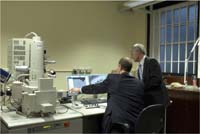May 25 2008
The Department of Conservation and Scientific Research at the British Museum has recently taken delivery of two new Hitachi analytical scanning electron microscopes (SEMs), to establish a state of the art electron microscopy facility. Scientists at the Museum provide insights into the past through research on collection material, artifacts and collaboration with scientists worldwide. Using both traditional and contemporary methods and scientific equipment, Museum scientists are able to answer questions to help with the interpretation and understanding of objects in the collection, leading to an increased knowledge in the development of cultures and civilizations.

Museum scientists decided that Hitachi was best placed to take their research and conservation needs forward with a combination of two advanced instruments and additional scientific collaboration. The Hitachi S-3700N variable pressure SEM will be used to examine and analyse objects and materials without preparation, a vital step forwards for Museum collections. The S-4800 field emission SEM is capable of resolving much greater detail and uses patented state of the art detectors to provide a range of surface, compositional and analytical data. The combination of having both VP and FEG in two microscopes covers the full range of SEM capabilities that are required for the present and future study of the museum’s wide range of object and material types. Large sample handling capabilities and flexible electron detection with high quality imaging ensure that the new facility helps maintain the Department’s position at the forefront of international research and conservation.
An appeal organised by the British Museum Friends and sponsors contributed generously towards funding for the instruments. The capability of the instruments was amply tested and illustrated prior to purchase, with Hitachi Applications Specialist, Chris Jones working in close collaboration with Nigel Meeks, who heads up the electron microscope facility, and Caroline Cartwright, materials scientist at the British Museum who specialises in the scientific analysis of organics including wood, charcoal, plant remains, shell, ivory and bone.
As an example application of the new SEMs, electron microscopy of Cassine peragua archaeological charcoal was carried out using both field emission and variable pressure SEMs, producing results for peer reviewed publication. Cassine peragua was chosen to evaluate the SEMs not only because of its anatomical characteristics but also because it is a taxon that is currently in the biological spotlight as it is undergoing taxonomic evaluation.
An official opening ceremony for the new facility was held recently, hosted by Dr David Saunders, Keeper of the Department of Conservation & Scientific Research. Attendees included contributors to the British Museum Friends’ appeal, scientists from throughout the British Museum and from other conservation groups around London such as Dr Alex Ball, Head of Electron Microscopy at the Natural History Museum, London.